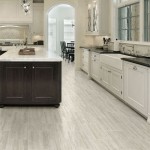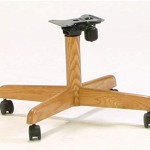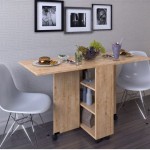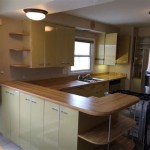Bamboo Floors in Kitchen: An Eco-Friendly and Stylish Choice
The kitchen, often considered the heart of the home, demands flooring that balances aesthetic appeal with practicality. Bamboo flooring has emerged as a compelling alternative to traditional materials like hardwood, tile, and laminate, offering a unique combination of environmental sustainability and design versatility. This article will delve into the characteristics of bamboo flooring, its suitability for kitchen environments, and the key considerations for homeowners contemplating this eco-conscious option.
Bamboo, scientifically classified as a grass, possesses remarkable growth properties. Certain species can mature in as little as three to five years, a significantly shorter timeframe compared to hardwoods that require decades to reach maturity. This rapid regeneration makes bamboo a renewable resource, contributing to its eco-friendly reputation. Furthermore, bamboo forests require minimal pesticides and fertilizers, reducing the environmental impact associated with their cultivation.
When processed into flooring, bamboo exhibits a range of desirable characteristics. It offers a natural and warm aesthetic, adding a touch of sophistication to any kitchen. Its durability and resistance to wear and tear make it suitable for high-traffic areas. Moreover, bamboo is relatively easy to maintain, requiring only regular sweeping and occasional mopping.
Understanding Bamboo Flooring Types
Not all bamboo flooring is created equal. Different manufacturing processes result in variations in appearance, durability, and cost. Understanding these distinctions is crucial for selecting the right type of bamboo flooring for a kitchen environment.
Horizontal Bamboo: This type of flooring is created by slicing bamboo stalks into strips, which are then laid horizontally and glued together. The resulting planks showcase the characteristic bamboo "knuckles," creating a distinctive and natural look. Horizontal bamboo is generally softer than other types and may be more susceptible to dents and scratches.
Vertical Bamboo: In vertical bamboo flooring, the bamboo strips are oriented vertically and glued together. This construction creates a more uniform and linear appearance. Vertical bamboo tends to be harder than horizontal bamboo, offering improved durability.
Strand-Woven Bamboo: This is the most durable type of bamboo flooring. The bamboo strands are shredded, compressed under high pressure, and bonded with adhesives. This process results in an exceptionally dense and hard material, often exceeding the hardness of many hardwood species. Strand-woven bamboo offers excellent resistance to scratches, dents, and moisture, making it a particularly suitable option for kitchens.
Engineered Bamboo: Similar to engineered hardwood, this flooring consists of a thin layer of bamboo veneer adhered to a core of plywood or fiberboard. Engineered bamboo offers enhanced dimensional stability, making it less prone to expansion and contraction in response to changes in humidity. This can be advantageous in kitchens, where moisture levels can fluctuate.
Benefits of Bamboo Flooring in the Kitchen
Bamboo flooring offers several advantages that make it a desirable choice for kitchen applications.
Eco-Friendliness: As previously mentioned, bamboo's rapid regeneration and minimal reliance on chemicals contribute to its environmentally sustainable profile. Choosing bamboo flooring can help reduce a homeowner's carbon footprint and support responsible forestry practices. Selecting bamboo flooring certified by organizations like the Forest Stewardship Council (FSC) ensures that the bamboo is sourced from sustainably managed forests.
Durability: While not as hard as some hardwood species like hickory or Brazilian cherry, strand-woven bamboo offers exceptional durability. It can withstand the daily wear and tear of a busy kitchen, including foot traffic, spills, and impacts. Horizontal and vertical bamboo, while less durable than strand-woven, can still provide adequate performance with proper care and maintenance.
Water Resistance: Bamboo possesses inherent water-resistant properties. However, it is not entirely waterproof. Excessive moisture exposure can cause bamboo to swell, warp, or stain. Promptly cleaning up spills and maintaining good ventilation in the kitchen can help prevent water damage. Engineered bamboo, with its stable core, offers improved resistance to moisture compared to solid bamboo flooring.
Style and Aesthetics: Bamboo flooring provides a warm and inviting aesthetic that complements a variety of kitchen design styles. Its natural grain patterns and color variations add visual interest and character to the space. Bamboo is available in a range of colors, from light blondes to rich ambers, allowing homeowners to coordinate it with their cabinetry, countertops, and other décor elements. It can be stained or finished to achieve a custom look. Additionally, its clean lines contribute to a contemporary and modern aesthetic.
Ease of Maintenance: Maintaining bamboo flooring is relatively straightforward. Regular sweeping or vacuuming removes dirt and debris. Damp-mopping with a mild cleaner is sufficient for most spills and stains. Avoid using harsh chemicals, abrasive cleaners, or excessive amounts of water, as these can damage the finish. Applying a fresh coat of finish every few years can help preserve the flooring's appearance and protect it from wear and tear.
Cost-Effectiveness: Bamboo flooring typically falls within a comparable price range to hardwood flooring, making it an accessible option for many homeowners. The initial cost can vary depending on the type of bamboo, the thickness of the planks, and the installation method. While strand-woven bamboo tends to be more expensive than horizontal or vertical bamboo, its superior durability justifies the investment in high-traffic areas like the kitchen. Additionally, the relatively simple installation process can help reduce labor costs.
Key Considerations Before Installation
Prior to installing bamboo flooring in a kitchen, several factors must be carefully considered to ensure a successful and long-lasting result.
Subfloor Preparation: A properly prepared subfloor is essential for the stability and performance of bamboo flooring. The subfloor should be clean, dry, level, and free of any imperfections. Any cracks, holes, or unevenness should be repaired before installation. Installing a moisture barrier is crucial, especially in kitchens, to prevent moisture from seeping up from the subfloor and damaging the bamboo. This is particularly important when installing over concrete slabs.
Acclimation: Bamboo flooring needs to acclimate to the kitchen's environment before installation. This process involves allowing the bamboo planks to adjust to the temperature and humidity levels of the room for several days or weeks. Acclimation minimizes expansion and contraction after installation, reducing the risk of gaps, cupping, or buckling. Follow the manufacturer's recommendations for acclimation procedures.
Installation Method: Bamboo flooring can be installed using various methods, including gluing, nailing, or floating. The choice of installation method depends on the type of bamboo, the subfloor material, and the homeowner's preferences. Gluing down provides a more stable and permanent installation, while nailing is often used for solid bamboo flooring. Floating installations involve connecting the planks together without attaching them to the subfloor, offering a quicker and easier installation process. This method is often used with engineered bamboo flooring.
Finishing: Bamboo flooring is typically pre-finished with a durable protective coating. However, homeowners may choose to apply an additional coat of finish after installation to enhance its durability and resistance to scratches and stains. Select a high-quality finish specifically designed for bamboo flooring. Regular maintenance, including re-coating the finish every few years, can help prolong the life of the flooring and keep it looking its best.
Potential Drawbacks: While bamboo flooring offers numerous benefits, it is important to acknowledge its potential drawbacks. As discussed earlier, it is susceptible to moisture damage if not properly maintained. Also, some cheaper bamboo flooring products may contain high levels of formaldehyde, a volatile organic compound (VOC) that can be harmful to human health. Look for bamboo flooring certified as low-VOC or formaldehyde-free.
Professional Installation: While DIY installation is possible for some types of bamboo flooring, professional installation is generally recommended, especially for gluing or nailing methods. Professional installers have the expertise and equipment to ensure a proper and long-lasting installation. They can also address any potential challenges or issues that may arise during the process. A properly installed bamboo floor will significantly improve the kitchen's aesthetics and increase the lifespan of the flooring.
In conclusion, bamboo flooring presents an attractive option for kitchens, offering a blend of eco-friendliness, style, and durability. By carefully considering the different types of bamboo, understanding its benefits and limitations, and following proper installation and maintenance procedures, homeowners can make an informed decision and create a beautiful and sustainable kitchen space.

Bamboo Flooring A Buyer S Guide This Old House
Bamboo Flooring Pros Cons And More

Bamboo Flooring Your Ultimate Guide For N Homes

Kitchen Flooring Ideas To Transform Your Space

Tips On Using Bamboo Flooring In The Kitchen Continental

Bamboo Flooring For High End Interior Floors A Sustainable And Stylish Choice Ilrarch
Bamboo Flooring Pros Cons And More

Bamboo Flooring Sydney Exploring The Floor Trend

4 Best Kid Friendly Kitchen Flooring Options

Moso Bamboo Kitchen Sustainable And Durable S
Related Posts








